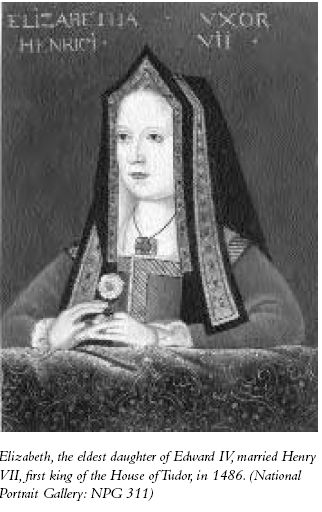- Elizabeth of York, Queen of England
- (1465–1503)Through her marriage to HENRY VII, Elizabeth of York, eldest daughter of EDWARD IV, sealed a union of the houses of LANCASTER and YORK that came to symbolize the end of the WARS OF THE ROSES and the legitimacy of the house of TUDOR.In 1469, four-year-old Elizabeth was betrothed to George Neville, son of John NEVILLE, marquis of Montagu, and nephew of Richard NEVILLE, earl of Warwick. The match evaporated in 1470, when the Nevilles overthrew Edward IV, and forced Elizabeth to accompany her mother, Queen Elizabeth WOODVILLE, into SANCTUARY at Westminster Abbey until Edward’s return in April 1471 (see Neville Family). In 1475, the king betrothed Elizabeth to the son of LOUIS XI of FRANCE as part of the Treaty of Picquigny, but the French king broke off that match in the early 1480s (see Charles VIII, King of France). After Edward IV’s death in April 1483, the queen, fearing her brother-in-law, Richard, duke of Gloucester, again fled into SANCTUARY at Westminster, taking her five daughters and her younger son, Richard PLANTAGENET, duke of York, with her. Gloucester secured custody of the duke in June, and by the autumn of 1483 York and his elder brother, EDWARDV,were commonly believed to have been murdered by Gloucester, who had taken the throne as RICHARD III in July. Now Edward IV’s heir, Elizabeth became an important element in BUCKINGHAM’S REBELLION, an uprising planned in part by her mother and in part by Margaret BEAUFORT, Countess of Richmond, and involving Henry STAFFORD, duke of Buckingham, heretofore an ally of Richard III. The rebels intended to enthrone Margaret Beaufort’s son, Henry Tudor, earl of Richmond, the surviving Lancastrian claimant to the Crown, and to marry him to Elizabeth. After the failure of the rebellion, Elizabeth remained in sanctuary with her mother and sisters until March 1484, when Richard III, in an effort to divorce the ex-queen from Richmond’s cause, agreed to find his nieces good marriages and to provide for them financially. Even though the PARLIAMENT of 1484 had bastardized the children of Edward IV, Elizabeth was so warmly welcomed at COURT that rumors soon claimed Richard was planning to replace his ailing queen, Anne NEVILLE, with his nineteen-year-old niece. The rumors intensified at Christmas 1484, when the queen and Elizabeth wore similar gowns at the court festivities, and in March 1485, when Queen Anne died. These reports were so persistent and so damaging to the king’s reputation that his chief advisors successfully urged him to take the unprecedented step of publicly repudiating the union. Although some later writers have claimed that Elizabeth was eager to marry Richard, the contemporary ballad, THE SONG OF LADY BESSY, described her loathing for her uncle, whom she blamed for her brothers’ deaths. Nothing can now be said with certainty about Elizabeth’s opinion of her uncle, who underscored his disavowal of the match by sending her to Sheriff Hutton. She was still at this Yorkshire castle in late August 1485, when Richmond defeated Richard at the Battle of BOSWORTH FIELD and took the throne as Henry VII. Because he was unwilling to have it appear he owed his Crown to his wife, Henry delayed his marriage to Elizabeth until January 1486, after Parliament had recognized his right to the throne. Elizabeth bore seven children, four of whom survived infancy. The eldest, Prince Arthur, preceded Elizabeth in death in 1502, but her second son became king as Henry VIII in 1509. Elizabeth died in February 1503 at the age of thirty-eight.Further Reading: Harvey, Nancy Lenz, Elizabeth of York (New York: Macmillan, 1973).

Encyclopedia of the Wars of the Roses. John A.Wagner. 2001.
